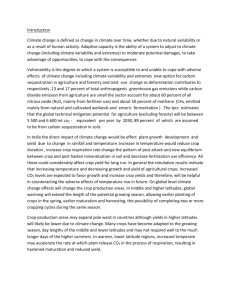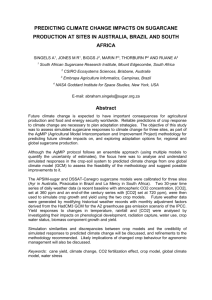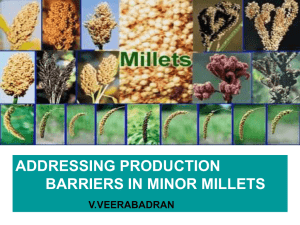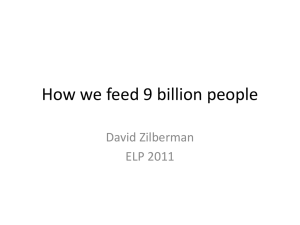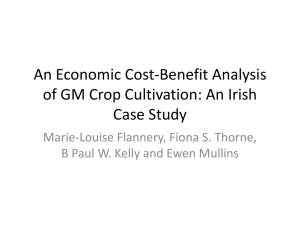ISPRS Archives XXXVIII-8/W3 Workshop Proceedings: Impact of Climate Change on... ANALYZING THE IMPACT OF RISING TEMPERATURE AND CO
advertisement
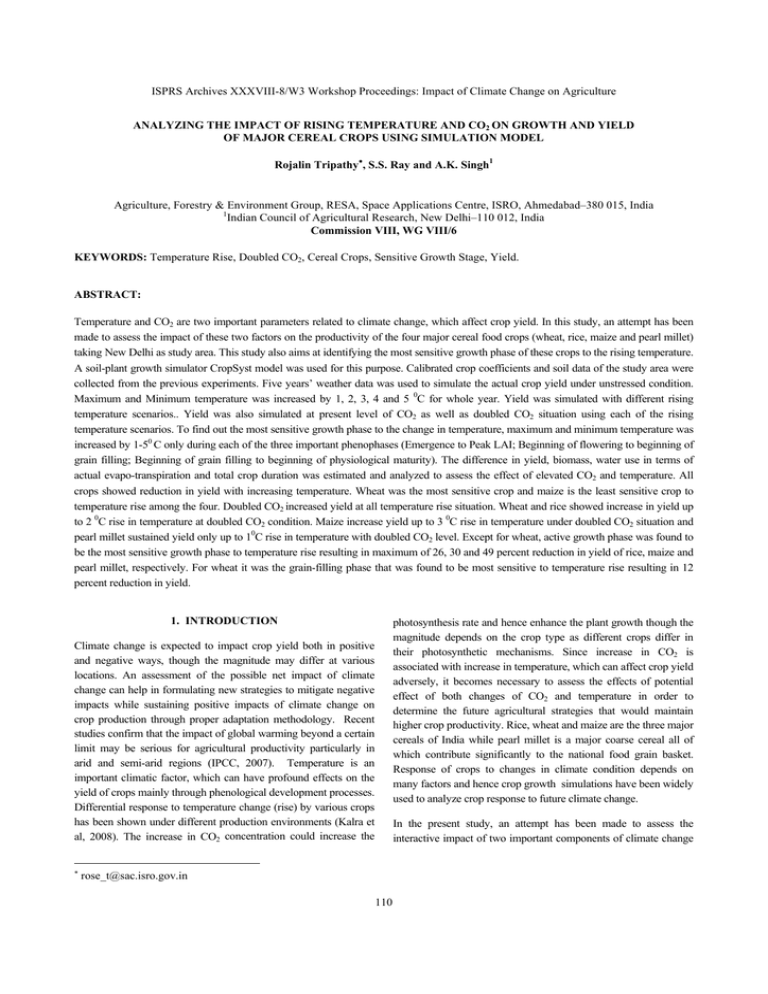
ISPRS Archives XXXVIII-8/W3 Workshop Proceedings: Impact of Climate Change on Agriculture ANALYZING THE IMPACT OF RISING TEMPERATURE AND CO2 ON GROWTH AND YIELD OF MAJOR CEREAL CROPS USING SIMULATION MODEL Rojalin Tripathy∗, S.S. Ray and A.K. Singh1 Agriculture, Forestry & Environment Group, RESA, Space Applications Centre, ISRO, Ahmedabad–380 015, India 1 Indian Council of Agricultural Research, New Delhi–110 012, India Commission VIII, WG VIII/6 KEYWORDS: Temperature Rise, Doubled CO2, Cereal Crops, Sensitive Growth Stage, Yield. ABSTRACT: Temperature and CO2 are two important parameters related to climate change, which affect crop yield. In this study, an attempt has been made to assess the impact of these two factors on the productivity of the four major cereal food crops (wheat, rice, maize and pearl millet) taking New Delhi as study area. This study also aims at identifying the most sensitive growth phase of these crops to the rising temperature. A soil-plant growth simulator CropSyst model was used for this purpose. Calibrated crop coefficients and soil data of the study area were collected from the previous experiments. Five years’ weather data was used to simulate the actual crop yield under unstressed condition. Maximum and Minimum temperature was increased by 1, 2, 3, 4 and 5 0C for whole year. Yield was simulated with different rising temperature scenarios.. Yield was also simulated at present level of CO2 as well as doubled CO2 situation using each of the rising temperature scenarios. To find out the most sensitive growth phase to the change in temperature, maximum and minimum temperature was increased by 1-50 C only during each of the three important phenophases (Emergence to Peak LAI; Beginning of flowering to beginning of grain filling; Beginning of grain filling to beginning of physiological maturity). The difference in yield, biomass, water use in terms of actual evapo-transpiration and total crop duration was estimated and analyzed to assess the effect of elevated CO2 and temperature. All crops showed reduction in yield with increasing temperature. Wheat was the most sensitive crop and maize is the least sensitive crop to temperature rise among the four. Doubled CO2 increased yield at all temperature rise situation. Wheat and rice showed increase in yield up to 2 0C rise in temperature at doubled CO2 condition. Maize increase yield up to 3 0C rise in temperature under doubled CO2 situation and pearl millet sustained yield only up to 10C rise in temperature with doubled CO2 level. Except for wheat, active growth phase was found to be the most sensitive growth phase to temperature rise resulting in maximum of 26, 30 and 49 percent reduction in yield of rice, maize and pearl millet, respectively. For wheat it was the grain-filling phase that was found to be most sensitive to temperature rise resulting in 12 percent reduction in yield. photosynthesis rate and hence enhance the plant growth though the magnitude depends on the crop type as different crops differ in their photosynthetic mechanisms. Since increase in CO2 is associated with increase in temperature, which can affect crop yield adversely, it becomes necessary to assess the effects of potential effect of both changes of CO2 and temperature in order to determine the future agricultural strategies that would maintain higher crop productivity. Rice, wheat and maize are the three major cereals of India while pearl millet is a major coarse cereal all of which contribute significantly to the national food grain basket. Response of crops to changes in climate condition depends on many factors and hence crop growth simulations have been widely used to analyze crop response to future climate change. 1. INTRODUCTION Climate change is expected to impact crop yield both in positive and negative ways, though the magnitude may differ at various locations. An assessment of the possible net impact of climate change can help in formulating new strategies to mitigate negative impacts while sustaining positive impacts of climate change on crop production through proper adaptation methodology. Recent studies confirm that the impact of global warming beyond a certain limit may be serious for agricultural productivity particularly in arid and semi-arid regions (IPCC, 2007). Temperature is an important climatic factor, which can have profound effects on the yield of crops mainly through phenological development processes. Differential response to temperature change (rise) by various crops has been shown under different production environments (Kalra et al, 2008). The increase in CO2 concentration could increase the ∗ In the present study, an attempt has been made to assess the interactive impact of two important components of climate change rose_t@sac.isro.gov.in 110 ISPRS Archives XXXVIII-8/W3 Workshop Proceedings: Impact of Climate Change on Agriculture the four crops (Active growth, flowering and grain filing) were taken into account. Thus total 300 weather files were generated for all crops with the five different range of temperature rise. i.e. temperature and CO2 on the productivity of the above mentioned four major food crops (wheat, rice, maize and pearl millet) taking New Delhi as study area using the CropSyst (Stockle et al., 1994) crop growth simulation model. This study also aims at identifying the most sensitive growth phase to the change in temperature in these crops. 2.4 Potential Yield Simulation Potential yield is the maximum yield of a variety constrained only by the local climatic parameters and assuming no other stress (nutrient and water). Thus it depends on maximum and minimum temperature, rainfall and other weather variables. Potential yield of wheat (PBW-343), rice (Pusa Sugandhi), maize (KH101) and pearl millet (PUSA 383) under current weather and CO2 condition as well as under different changing scenarios with rise in temperature and CO2 was simulated using CropSyst model (Sockle et al, 1994). It calculated dry matter accumulation as a function of daily intercepted solar radiation and daily crop transpiration, using constant coefficient of radiation us efficiency, RUE (Monteith, 1981) and transpiration efficiency, K (Tanner and Sinclair, 1983). Modifications were introduced to CropSyst in order to account for the effect of atmospheric CO2 on plant growth and water use (Stockle et. al., 1992). For more information on CropSyst readers are referred to Stockle et al (1994) and Jara and Stockle (1999). 2. METHODOLOGY 2.1 Study Site The crop, weather and soil data required for the present investigation were taken from the research farms at Indian Agricultural Research Institute, New Delhi (28o 38'N, 77.10' E) situated at an elevation of 228 m above MSL. The soil is classified as Typic Haplustept and is sandy clay loam in texture. The climate of the study area is semi-arid with an annual maximum and minimum temperatures ranging from 43.9 to 45.0 and 6.0 to 8.0 0C, respectively. The mean summer and winter temperatures are 33.0 and 17.3 0C, respectively. The mean annual rainfall is around 700 mm, of which more than 75% is received in the months of July to October (kharif season). The soil texture of the experimental site is clay loam with slightly alkaline pH of 7.75, bulk density of 1.52 g/cc, hydraulic conductivity of 1.01 cm/hr, field capacity of 39.9 %(cc/cc) and permanent wilting point of 6.8 % (cc/cc). Initial CO2 was fixed at 375 ppm. Another set of simulation was generated with doubled CO2 concentration of 750 ppm. 16th July was used as transplanting date for rice, for wheat it was fixed at 23 Nov, for maize 8 Aug and for pearl millet 1 Aug was taken as sowing date. Growth and yield of each crop was simulated for five years (2000-2005) for actual weather and generated weather with rising temperature scenarios as well as CO2 level of 375 and 750 ppm (doubled CO2). 2.2 Input Data Weather data of the study area were collected from the Observatory of Indian Agricultural research Institute for a period of five years (2000-2005). This includes Maximum and Minimum temperature, Relative humidity, Rainfall and wind speed. Solar radiation was estimated using Hargreaves formula using Maximum and minimum temperature, site-specific extra terrestrial radiation and site-specific regression coefficient generated earlier (Tripathy et al, 2008). Calibrated crop coefficients of the four crops and soil data of the study area were collected from the previous experiments (Singh et al., 2008). The crop varieties for which calibrated coefficients were taken are PBW-343 (wheat), KH101 (maize), Pusa Sugandhi (Rice) and PUSA 383 (pearl millet). The calibrated coefficients were validated for another year. Soil physical and chemical properties were taken from the published literature (Singh et al., 2008). 2.5 Analysis of Impact of Rising Temperature and Net EFFECT of CO2-Temperature Rise Absolute difference and percentage difference between the simulated crop duration, leaf area index (LAI), water use and yield using actual weather data and those with the rising temperature data was calculated for each year and averaged out, which indicated the impact of rise in temperature on the above parameters. For studying the net effect of rising temp and CO2, absolute difference and percentage difference between the simulated yield using actual weather data and that simulated with the rising temperature data with 750 ppm CO2 was calculated for each year and averaged out. The average differences for each generated scenario was analysed for indicating the sensitivity of temperature to different cereal crop, and also to find out the most sensitive growth phase of each crop to rising temperature. Interactive impact of CO2 was also analysed to see whether the positive effect of expected range of rising CO2 can mitigate the adverse effect of temperature on crop yield and if yes to what extent. 2.3 Generation of Weather Files with Rising Temperature Weather files were prepared for the CropSyst model using the original data for the period of 2000-2005. Both maximum and minimum temperature of the original weather file were increased by 1, 2, 3, 4 and 5 0C for whole year to generate new weather files for each year. Likewise for a single crop total twenty-five weather files for the five-year period were generated. For finding out the most sensitive crop growth phase to temperature rise, new weather files were generated by restricting the temperature rise to the respective growth phase. The important growth phases of each of 111 ISPRS Archives XXXVIII-8/W3 Workshop Proceedings: Impact of Climate Change on Agriculture the floral reproduction, increase the spikelet sterility due to stomatal closure and reduce fertilization (Satake and Yoshida, 1978; Nishiyama and Satake, 1981; Matusi et al., 1997). The resulted decline in wheat yield is in agreement with the study of Kalra et al. (2008), which showed a rise of 30C can result 40 % decline in wheat yield in Haryana. Lal et al (1998) also reported similar reduction in wheat yield due to temperature rise. They also reported 41 % reduction in rice yield due to 40C rise in temperature. Reduction in rice yield with rising temperature as simulated in the present study is also corroborated with the result of Krishnan et al. (2007). 3. RESULTS AND DISCUSSION 3.1 Yield Response of Different Crops to Rising Temperature and CO2 The simulation results showed that any increase in temperature at all the CO2 levels would cause decline in yields but an increase in CO2 level at each temperature increment would increase yields. Here first the effect of rising temperature alone is discussed and then the interactive effect of rising CO2 and temperature is discussed. Yield, biomass and water use in terms of actual evapotranspiration declined with increase in temperature (Table 1). Winter crop (wheat) was found to be more sensitive to higher temperature than the kharif crops (maize and rice). The yield reduction ranged from 8 to 66 percent in wheat with a reduction in total crop duration by 6-32 days. In rice the reduction in yield ranged from 11 to 41 percent while the total crop duration reduced by 20-50 days when temperature was raised by 1-50C for the whole season. Maize showed 9-37 percent reduction in yield and 8-25 days reduction in total crop duration. The yield reduction in pearl millet was 14-58 percent and total crop duration in this case was reduced by 5-18 days. Among the four crops wheat showed maximum sensitivity with highest reduction in yield (about 67 %) with 5 0C rise in temperature (Figure 1). Reduction in Crop Duration (Days) Wheat Maize Millet 1 20 6 8 5 2 31 12 11 9 3 39 21 15 12 4 45 27 19 15 5 50 32 25 18 1 11.31 2 3 28.75 29.75 21.63 35.91 16.69 26.24 24.73 37.25 4 37.25 50.98 32.81 53.33 Wheat 1 2 Maize Pearl millet 60 50 40 30 20 10 41.52 66.75 37.36 57.95 4.53 3.62 8.02 25.83 6.39 9.38 3 11.01 37.93 11.49 14.75 4 13.38 49.39 14.01 23.88 5 15.21 60.41 15.13 25.03 5 Figure 1. Yield Reduction in Different Cereal Crops with Temperature Rise The decline in yield due to temperature stress was compensated through doubling the CO2 level to 750 ppm, though the range is different at different temperature rise scenarios. Doubled CO2 level completely mitigated the adverse effect of temperature rise up to 20 C in all crops except pearl millet and the resulted yield was more than the current yield (Figure 2). However, beyond 2 0C, rising CO2 could not completely mitigate the adverse effect of rising temperature in rice and wheat. In maize the doubled CO2 compensated the yield reduction due to temperature rise up to 3 0C. The interactive effect of rising temperature and CO2 is depicted in figure 2. Among the four cereal crops, the positive effect of rising CO2 was more in maize as compared to other crops. 5.26 2 4 0 Reduction in crop yield (%) 7.86 9.49 14.45 10.89 3 Rise in temperature ( C) Reduction in Actual evapo-transpiration (%) 1 Rice 0 Rice 5 70 Reduction in grain yield (%) Rise in Tempera ture (0C) 80 An increase in the CO2 level enhances photosynthesis and increase water use efficiency by producing more tillers per plant (Baker et al, 1990), which in turn increased crop productivity. The increased growth response with increasing CO2 concentration was attributed to greater tillering and more grain-bearing panicles. The net assimilation rate and canopy net photosynthesis also increased with increasing CO2 concentration. The Impact of elevated CO2 in maize was more than other crops, which may be because maize being a C4 crop could use the increased CO2 more efficiently than the other C3 crops. Table 1: Change in Total Crop Duration, Grain Yield and Actual Vapo-Transpiration (AET) due to Rise in Temperature The negative effect of rising temperature on yield of different crops may be due to the fact that it increased the rate of respiration and shortened the vegetative and grain filling stage (Horie et al, 1995). Many researches have showed that high temperature could reduce 112 ISPRS Archives XXXVIII-8/W3 Workshop Proceedings: Impact of Climate Change on Agriculture 30 20 10 0 -10 -20 -30 -40 -50 -60 -70 3.2 Sensitive Growth Phase of Different Crops to Rising Temperature Wheat 1 2 3 4 5 Maize 20 10 0 -10 -20 -30 -40 1 2 3 4 10 5 Rice 0 -10 -20 -30 -40 1 2 3 4 20 5 Pearl millet 10 0 -10 -20 -30 -40 -50 -60 1 2 3 4 5 Figure 3. Sensitive Growth Phase of Different Cereal Crops to Temperature Rise Rise in Temperature Figure 2. Changes in Grain Yield of Different Cereal Crops to Temperature Changes for Present-day and Doubled Atmospheric CO2 Conditions In wheat the rise in temperature by 1 and 2 0C during active growth stage increased the grain yield by 1.33 and 1.04 %, respectively. Thereafter yield declined (Figure 3). Temperature rise during flowering stage resulted in 2.8 to 5.9 % reduction in yield. 113 ISPRS Archives XXXVIII-8/W3 Workshop Proceedings: Impact of Climate Change on Agriculture H.F. (Eds.), Climate change and Global crop productivity. CABI Publishing, Wallingford, Oxon, pp. 81–106. Rise in temperature during grain filing stage resulted in 1.8 to 12 % yield reduction when temperature was raised from 1 to 5 0C. Same increment in temperature, for rice crop, during active growth stage resulted in 5.5 to 26.48 % yield reduction; during flowering stage resulted in 1.5 to 8 % yield reduction and during grain filling stage resulted in 1.19 to 4.86 % yield reduction. In maize the yield reduction ranges from 8.2 to 30 %; 0.63 to 3.43 % and 2.45 to 10.10 % when the temperature rose from 1-5 0C during active growth, flowering and grain filling stage, respectively. In pearl millet the temperature rise during active growth stage resulted in 9.8 to 49 %, temperature rise during flowering resulted in 6.04 to 24.63 % yield reduction and during grain filling resulted in 0.69 to 2.51 % yield reduction. Intergovernmental Panel on Climate Change, 2007b. In: Climate Change 2007: Impacts, Adaptation and Vulnerability. Contribution of Work Group II to the Fourth Assessment Report of the Intergovernmental Panel on Climate. Cambridge, UK. Cambridge University Press. Jara, J and Stockle, C.O.,1999. Simulation of corn water uptake using models with different levels of process detail. Agronomy Journal. 91, pp. 256-265. Kalra, Naveen, Chakraborty, D., Sharma, Anil, Rai, H. K., Jolly, Monica, Chander, Subhash, Ramesh Kumar, P., Bhadraray, S., Barman, D., Mittal, R.B., Mohan Lal, Sehgal, Mukesh 2008. Effect of increasing temperature on yield of some winter crops in northwest India Current Science, 94 (1), pp. 82- Except for wheat, active growth phase was found to be the most sensitive growth phase to temperature. In case of wheat the grainfilling phase was found to be most sensitive to temperature rise resulting in 12 percent reduction in yield (Figure 3). Krishnan, P., Swain, D.K., Bhaskar, B. Chandra, Nayak, S.K., Dash, R.N., 2007. Impact of elevated CO2 and temperature on rice yield and methods of adaptation as evaluated by crop simulation studies Agriculture, Ecosystems and Environment, 122, pp. 233–242. CONCLUSION From the present study it may be concluded that rabi (winter) crops are (wheat) more sensitive to high temperature stress than the kharif crops. The positive effect of CO2 was more in C4 crops (maize) as compared to C3 crops. The present study also indicated that adverse effect of rising temperature could be mitigated through the doubled CO2 up to 10C in pearl millet, up to 20C in rice and wheat, up to 3 0C in maize. However, rise in temperature beyond that temperature could cause significant reduction in yield of all cereal crops under the present management environment. Hence further research is required to find out the appropriate management practices to sustain the present level yield in a changed climate condition. This study could identified the critical phenological stages of the cereal crops taken in this study, which can be an input for adaptation practices, especially, while planning for modification of sowing date. Matusi, T. Namuco, O.S., Ziska, L.H., Horie, T., 1997. Effect of high temperature and CO2 concentration on spikelet sterility in Indica rice. Field Crops Research. 51, pp. 213-219. Nishiyama, I., and Satake, T. 1981. High temperature damages to rice plant. Japanese Journal of Tropical Agriculture, 25, pp. 14-19. Satake, T and Yoshida, S. 1978. High temperature induced sterility in indica rice at flowering. Japanese Journal of Crop Science, 47, pp. 6-11. Singh, A.K., Parihar, S.S, Mishra, A.K., Goyal, Vishal, Chongloi, Lewish K., 2008. Scientific Report on Validation of CropSyst Simulation Model at Field and Irrigation Command Levels. Water Technology Centre, IARI, New Delhi. ACKNOWLEDGEMENT This work was carried as part of the PRACRITI programme of Department of Space. The first two authors are grateful to Dr. R. R. Navalgund, Director, SAC, Dr. J. S. Parihar, Deputy Director, RESA, Dr. Sushma Panigrhy, Group Director, AFEG and Dr. N. K. Patel, Head, CMD for their kind encouragement and keen interest in the work. REFERENCES Stockle, C.O., Martin, S., Campbell, G.S., 1994. CropSyst, a cropping systems model: water/nitrogen budgets and crop yield. Agricultural Systems, 46, pp. 335-359. Stockle, C.O., Williams, J.R., Rosenberg, N.J., Jones, C.A.1992. A method for estimating the direct and climatic effect of rising atmospheric carbon dioxide on growth and yield of crops: part I Modification of the EPIC model for climate change analysis. Agricultural Systems, 38, pp.225-238. Baker, J.T., Allen Jr., L.H., Boote, K.J., 1992b. Response of rice to carbon dioxide and temperature. Agriculture Forest Meteorology, 60, pp. 153–166. Tripathy, Rojalin, Chaudhari, K.N., Patel, N.K., 2008. Evaluation of different methods to estimate incoming solar radiation. Journal of Agrometeorology, 10 (special issue-part1), pp. 174. Horie, T., Baskar, J.T., Nakagawa, H., 2000. Crop ecosystem responses to climate change: Rice. In: Reddy, K.R., Hodges, 114
